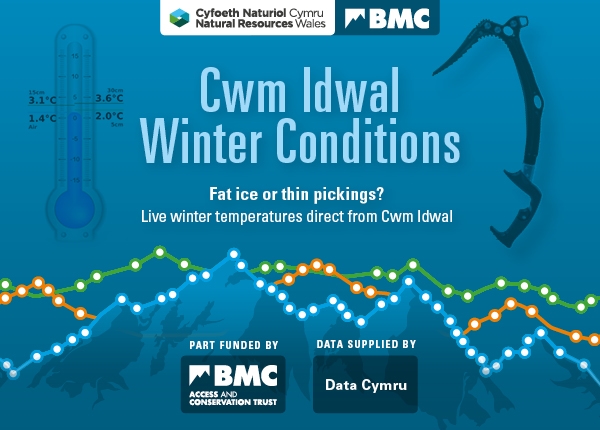Welsh winter conditions now live
- Friday 19th December 2014
Dec 19th 2014
An exciting and ground breaking project is now live and giving climbers actual winter conditions on a number of key Welsh winter crags.

The project, a collaboration between the BMC and Natural Resources Wales, the National Trust and Snowdonia National Park, is to pilot live winter condition information, including temperatures, direct from Cwm Idwal.
In addition to the original senor which was placed at the base of the Devil’s Kitchen, a second sensor has now been placed at the foot of Clogwyn Du, giving live temperature information and updates on the state of the turf at 850m. This is especially useful as Clogwyn Du is one of the very first winter crags to come into condition in Wales and contains some of the most popular and also the hardest mixed routes in the UK. However, as some of the routes climb directly through some extremely fragile habitats containing some of the rarest and most fragile mountain and alpine vegetation found growing in the UK.
Although climbers will clearly benefit by knowing whether routes are in condition or not, the underlying purpose is to help protect the environment by reducing damage to vegetation including rare plants which occurs when routes are climbed in marginal conditions. It is hoped that climbers will avoid the crags when they are in marginal conditions thereby obviating the need for more formal arrangements (ie bans).
Work on the ground started in late in December 2013 to install the remote temperature sensing station on a rock bluff below the cliffs of the Devils’ Kitchen in Cwm Idwal. This sensor generates live data and records not only the air temperature but also the temperature of the turf at 5cm and the ground at 15 and 30 cm. This information is then sent by radio signal to an internet feed at Ogwen cottage and then to the BMC website.
As well as supplying live data the project is keen to harvest actual conditions as observed by climbers visiting the crags. Therefore anyone who visits Cwm Idwal can post their observed conditions on the comments section of the website.
Finally, if successful this technology could be extended to other cliffs with similarly sensitive flora elsewhere in Snowdonia and the rest of the UK.
To view the actual winter conditions click through here…